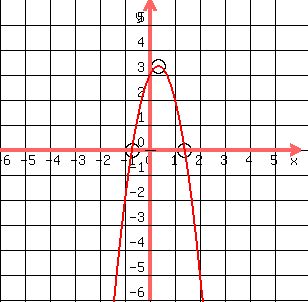Hi
f(x)= -3x^2+2x+3
Finding x-intercepts when f(x)=0
-3x^2+2x+3 = 0
 |Using Calculator
|Using Calculator
x = -0.72, 1.39 |x-intercepts P(-.72,0) and Pt(1.39,0)
Finding vertex
Using the vertex form of a parabola,  where(h,k) is the vertex
where(h,k) is the vertex
f(x)= -3x^2+2x+3 |completing square to put into vertex form
f(x) = -3[(x-1/3)^2 -1/9] + 3
f(x) = -3(x-1/3)^2 +1/3 + 3
f(x) = -3(x-1/3)^2 +10/3 Vertex is Pt(1/3,10/3)
